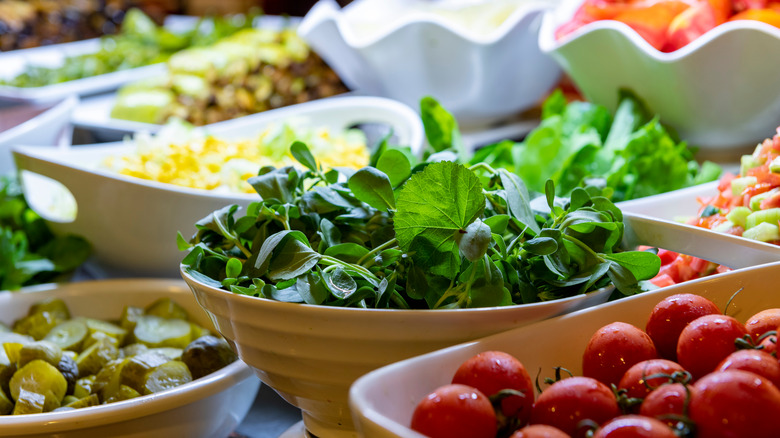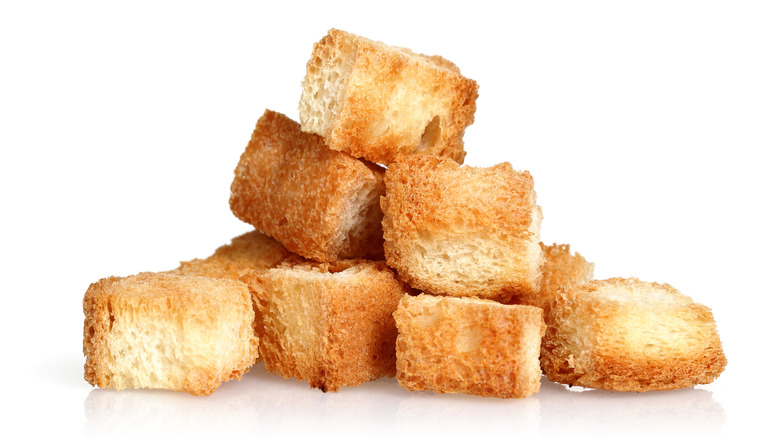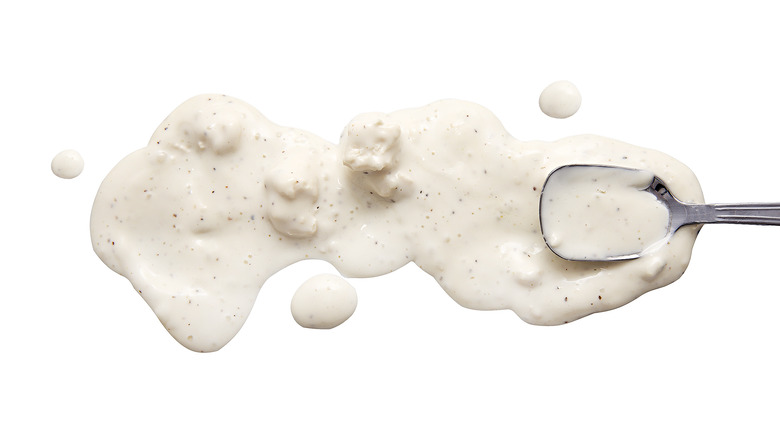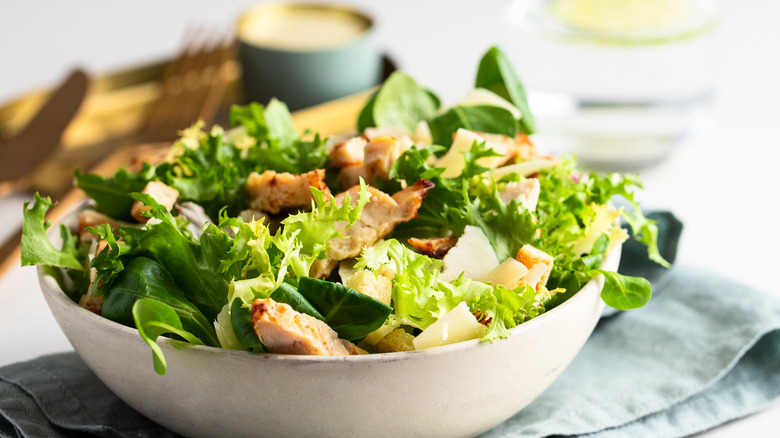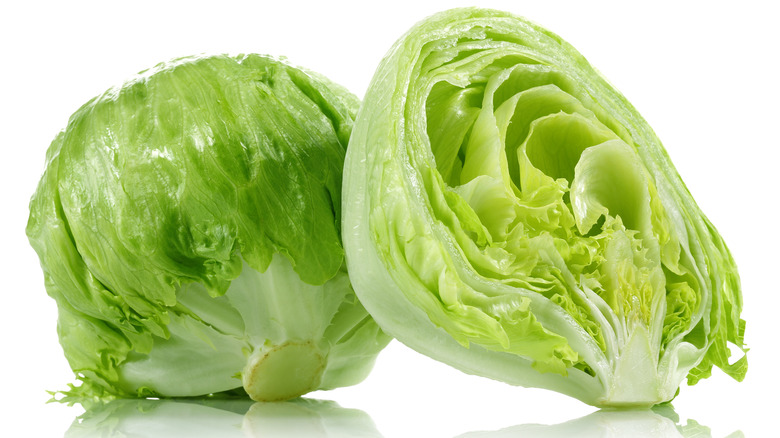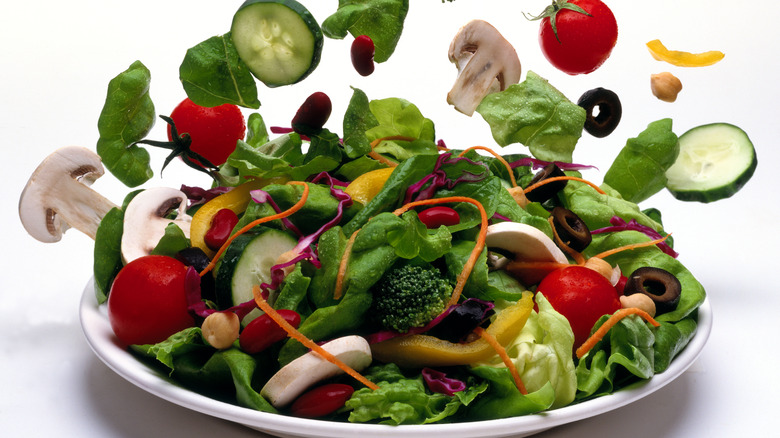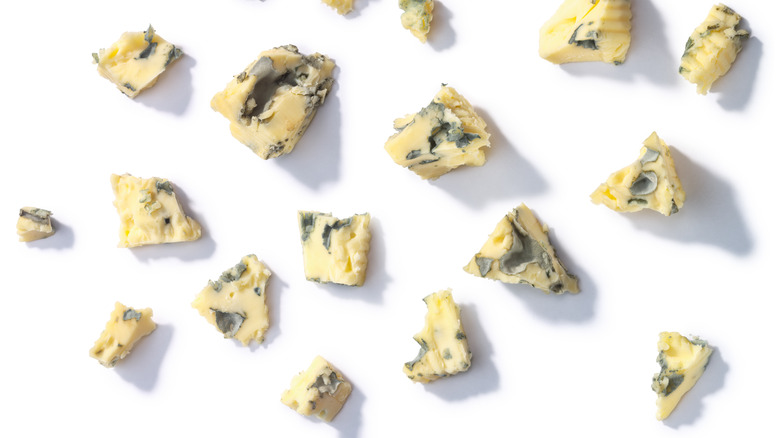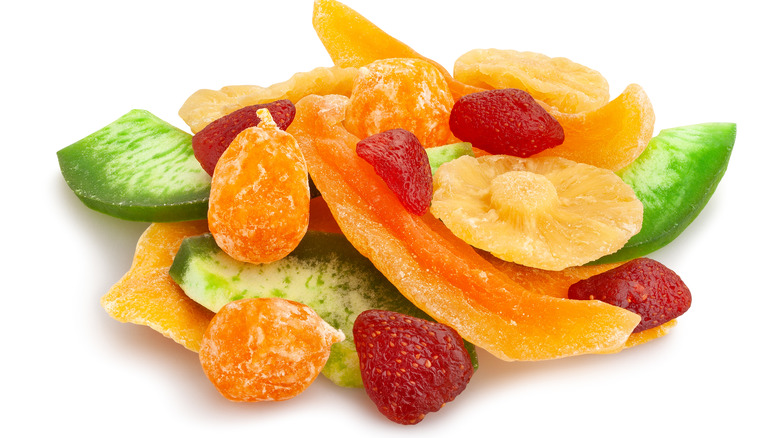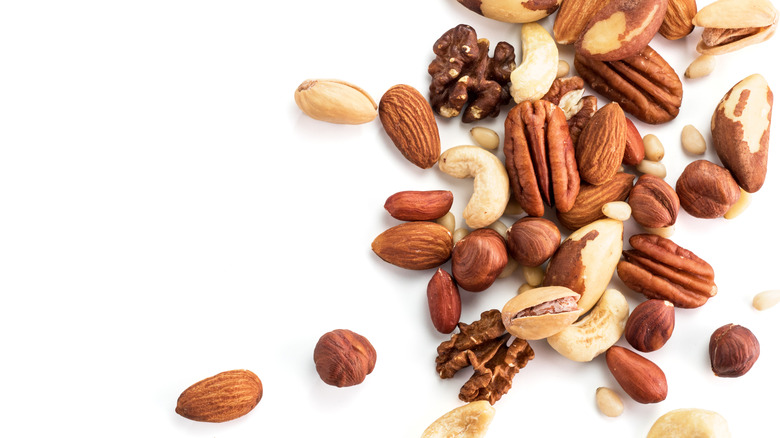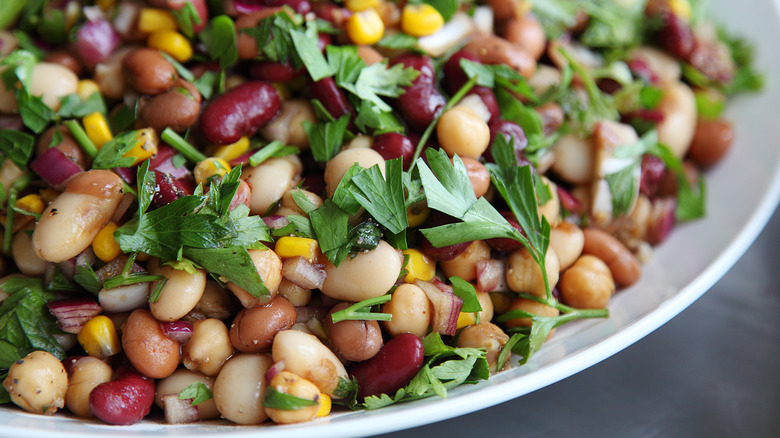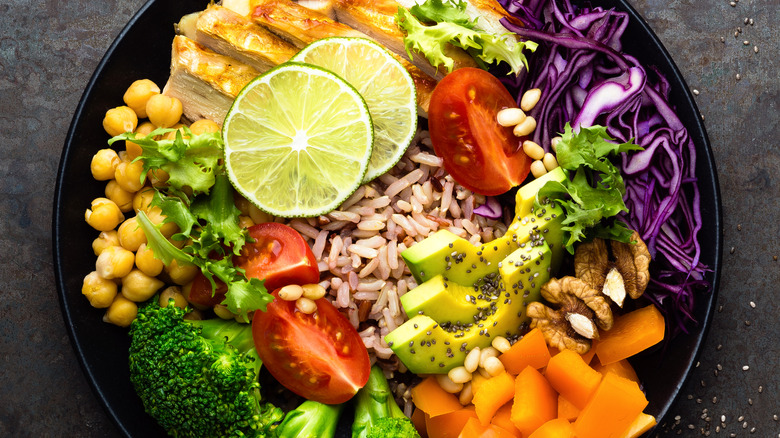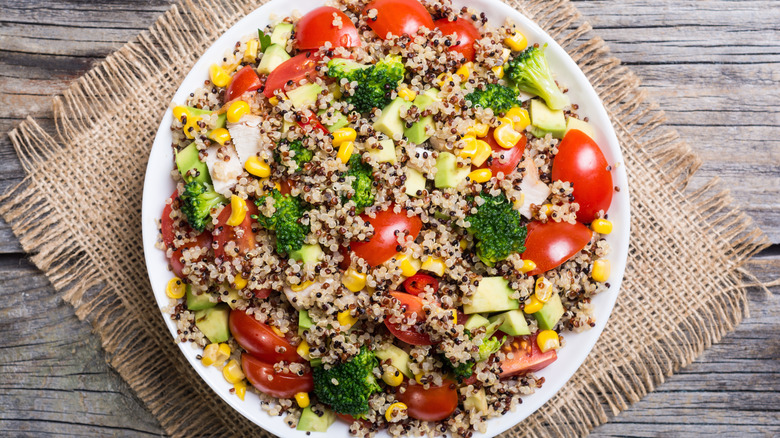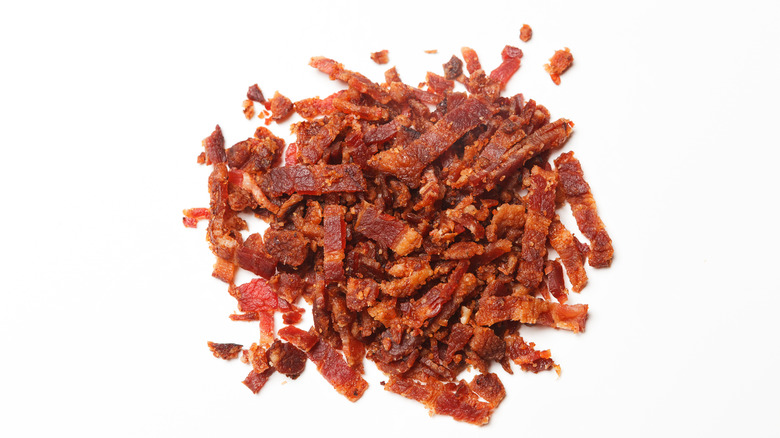Are You Making These 12 Mistakes At The Salad Bar?
If healthy is your goal, then you may want to consider hitting up the salad bar the next time you dine out. But it's not quite so simple, as you need to beware of the factors that can ruin an otherwise heart-smart option. With so many options on offer at a salad bar, you may end up randomly piling items onto your plate. What's more, it's easy to go overboard on the empty-calorie toppings, high-fat options, and those hidden and not-so-hidden sugars in things like salad dressings and sugar-coated nuts. And though a salad starts with leafy green, it may be surprisingly easy to skimp on those when those croutons, bacon bits, and candied pecans are calling your name.
When building your salad, it's best to pack in the veggies, add in some protein (and complex carbs), and go light on the dressing and crunchy toppings. Here are some common mistakes you might be making at the salad bar and how to avoid them.
Going crazy for the croutons
Croutons may be a nice complement to creamy ranch dressing and crisp salad greens. But these seemingly innocuous carbs may add more harm than benefit if you overdo it on those crunchy cubes of bread.
Those toasty, sometimes flavored bread cubes are typically made from refined white bread. This means that, though the wheat flour is often fortified, the wheat has been stripped of the germ and bran, which are fibrous and nutrient-dense components of the grain. But a lack of fiber is not the only concern when it comes to loading up on croutons. Croutons may also be high in fat, sodium, and additives that can wreak havoc on your body. They are often buttered before baking, which adds more saturated fats to your diet. And in some cases, croutons are even fried, bringing more fat to the table. What's more, packaged croutons are often processed with partially hydrogenated soybean oils, high fructose corn syrup, and added salt.
If you love that crunch, consider using fewer croutons, such as two to three large croutons or four to six small ones. For an extra boost, use a sprinkling of nutrient-dense nuts or seeds instead.
Getting too generous with the salad dressing
It may be wise to stick with the oil and vinegar when it comes to dressing your salad. Keeping it simple and less processed means you have fewer added sugars, salts, or additives to worry about. Processed dressings are often high in fat and sodium, and may have added sugars. You could go with low-fat versions, yet these still may contain extra sugar.
This doesn't mean you can't enjoy your favorite creamy dressing. The problem is that many people don't seem to be aware of the amounts they pour on — ending up with globs of dressing that can weigh a salad down. With too much dressing, even a salad prepared with chopped veggies and greens can be a gut bomb.
Considering that just two tablespoons of ranch can add 140 calories and 14 grams of fat to your salad, it's important to be mindful of how much you use. One tip: serve your dressing on the side and drizzle it onto your salad with a fork at your table. Going easy on the dressing will also let the flavors of your veggies and fruits shine through, like the mildly sweet flavor of baby spinach or the earthy umami richness of sliced mushrooms.
Not getting enough protein
A salad may be a great way to pack in those heart-healthy leafy greens, but you may be forgetting an important nutrient: protein. Sure, dark leafy vegetables contain some essential amino acids (the building blocks of protein), but one cup of kale provides less than 1 gram of protein. In fact, you'd have to eat an entire head of Romaine lettuce (roughly 6 cups ) to get close to 8 grams of protein. Eating a lot of fibrous foods all at once can cause bloating, so we can't fully recommend that.
If your salad is lacking sufficient amounts of high-quality protein, you may wind up hungry soon after your meal. Quality protein means your choice is a complete protein with good levels of all nine essential amino acids. It should also be easily digestible, meaning it's low-fat like lean cuts of meat or a nutrient-rich egg. Adding quality protein to your salad can keep you steadily energized and prevent spikes in your blood sugar.
Some great protein options you may find at most salad bars include chopped or shredded chicken, cottage cheese, and eggs. If you don't eat dairy or meat, consider quinoa (a complete protein), tofu, or beans.
Going light on the greens
We hate to break it to you, but iceberg lettuce offers the least nutritional value when it comes to your leafy greens. Sure, you can still get benefits from eating any leafy green, as even iceberg lettuce contains some folate and vitamin A, has very few calories, and does have a relatively high water content for your hydration needs. Still, it is lower on the totem pole when it comes to the more nutrient-dense options like romaine, kale, and spinach – which contain several B vitamins and are a rich source of vitamins K, C, and A. They even offer a good dose of potassium, which can help keep your blood pressure under control, as per the CDC.
If you absolutely love that iceberg crunch, consider pairing it with other leafy greens to get more nutrients. A variety of dark leafy greens can add to a salad's texture, flavor, and, of course, nutrition. We recommend you go with at least one cup of greens for your base since it actually takes two cups of leafy greens to make the nutritional equivalent of a serving of veggies. The USDA (via Harvard School of Public Health) recommends that adults over 51 consume 2 to 2.5 cups of vegetables per day.
Skimping on the rainbow
If your salad doesn't contain a variety of colorful components, you may be missing out on some important nutrition (not to mention visual appeal). No, we are not talking about dried pineapple, cranberries, or golden raisins (although you might add a few). Instead, we mean the rainbow you get from a variety of fresh fruits and veggies, including bell peppers, cucumbers, tomatoes, beets, fresh blueberries, and leafy greens. These colorful foods provide heart-healthy antioxidants that can give your skin a glow, boost your immunity, protect your eye health, and keep your mind sharp, as per RUSH University Medical Center.
So, to make a healthy salad, make more room for bright, crisp, colorful veggies. Do so by going lighter on the prepared salads like those of the potato and tuna variety. Not only do they tend to be less vibrant, but they generally have added sugars and hidden sodium, and may be high in fat thanks to mayo-based dressings.
Getting too cheesy
Cheese can be a part of a healthy diet as it is a source of protein and some essential vitamins and minerals such as calcium. But it is also high in salt, cholesterol, and saturated fats. So, if you often "say cheese," do it sparingly.
According to the Physician's Committee for Responsible Medicine, the cons of cheese may outweigh its benefits. High levels of saturated fat and sodium can increase the risk of heart disease and certain types of cancers. The calcium in dairy may not be what it's nearly cracked up to be, either. According to a 2015 review published in BMJ, studies are inconclusive regarding the effectiveness of calcium when it comes to preventing fractures. That being said, calcium is still an important nutrient that aids in heart function and can be found in a variety of plant-based foods.
If you still say yes to cheese, remember to limit your portions. For a salad, stick with a tablespoon of crumbled blue cheese or feta or a light sprinkling of parmesan. Just a small amount can go a long way when it comes to punching up the flavor in your salad.
Topping salad like a dessert
Bits of sweet, crunchy, and chewy components can certainly make your salad appealing. Just don't turn it into a dessert. If you are drawn to sugar-coated nuts and tropical dried fruit, you may want to rethink your toppings (or use a bit less), as the sugars, saturated fats, and hidden sodium here can add up. Consider that just ¼ cup of Sante candied pecans contains 3 grams of saturated fats, 4 grams of sugar, and 75 mg of sodium. And while fruit is a win for its nutrient-dense composition, dried fruit is highly concentrated in its natural sugars, not to mention those added sugars you often find in dried pineapple, banana chips, and dried mango bits.
You may know that a diet high in sugar and saturated fats poses a heightened risk for heart disease, as per Progress in Cardiovascular Diseases. These compounds may also harm your brain. According to a 2013 study published in Neuroscience, a western diet (one high in sugars and saturated fats) impairs cognitive function by affecting the brain's hippocampus. Rats fed the western diet experienced lowered brain function, increased blood sugar, and higher rates of obesity. So, when it comes to the salad bar, go light with sugary add-ons.
Getting too nutty
It's not a bad idea to add some nuts to your salad. You can use them to get important nutrients such as vitamin E, vitamin A, and zinc. They can also support your intake of healthy unsaturated fats and omega-3 fatty acids. But just one ounce of nuts alone can bump your meal up 160 to 200 calories, as they tend to be high in fat. In fact, one ounce of walnuts contains 18.5 grams of fat.
What's more, too many nuts can cause digestive issues. Because nuts are high in fats and fiber, they take longer to digest. More time in the digestive system means they can increase your risk of bloating. They also contain tannins, which don't always sit so well in the stomach, especially in high amounts. So, less is more when it comes to nuts. Enjoy them in your salads, but don't get too nutty.
Passing on the beans
Yes, we all know, beans can make you pass a little gas (or loudly toot that horn). But including a little in your salad is a great way to go — try two tablespoons to start. Beans offer a plethora of nutritional benefits. For the same amount of calories you may get from one ounce of dressing, one-half cup of black beans (114 calories) provides 8 grams of protein and 8 grams of fiber (and none of the saturated fat)! Plus, you'll get the benefit of potassium, which the CDC notes can help to control your blood pressure. Beans also offer complex carbohydrates that can benefit your digestion. As a rich source of soluble fiber, beans are beneficial for cholesterol and blood sugar control, as per Healthline.
Those tiny morsels can add texture to your salad and visual appeal. Choose from black beans, red kidney beans, or neutral cannellini to add color or contrast to your leafy green salad.
Not creating a well-balanced plate
"Half your plate" has been a popular slogan for several years, at least when it comes to loading up your meal with fruits and vegetables. MyPlate was introduced in 2011 and adopted by the USDA in place of the classic food pyramid guideline. With the MyPlate model, you can imagine that half your bowl is filled with fruits and veggies (mostly veggies). You then add in your remaining food groups from there.
When it comes to salad, try splitting your protein portion between 2 ounces of chicken and ¼ cup of edamame. Brown rice and beans also provide a complete plant protein option with complex carbs. Add a sprinkling of nuts and seeds to get in some heart-healthy fats (and some fiber and a bit more protein) and crunch. You can even opt for a few slices of avocado, a great source of fiber and heart-healthy fats.
Missing out on whole grains
It might be easy to pass up those hearty whole grains waiting for you at the salad bar, such as brown rice or corn, especially when you are craving crunchy fried wontons or other carby toppings. But there are quite a few reasons why you'll want to include a portion of them in your salads. For one, whole grains contain more fiber and heart-healthy nutrients than refined grains like bread, crackers, pasta, and white rice. They are also typically more filling and satisfying and have a lower glycemic index that won't cause your blood sugar to go wild.
If you like some additional texture in your salads, go with a more toothsome sort of cooked grain such as brown rice or quinoa to complement the other textures, colors, and flavors in your salad. Both of these options pair nicely with nuts, seeds, and legumes, including beans.
Going heavy on the bacon (bits)
Bacon bits typically clock in at just 25 calories per tablespoon and 1.5 grams of fat, plus 3 grams of protein. This doesn't sound horrible, but if you double the amount, you'll be adding 2 grams of saturated fat to your salad and over 400 milligrams of sodium to your diet (almost 20% of your daily recommended intake).
Imitation bacon bits may be vegan-friendly and often have zero saturated fats, but they are highly processed with artificial colors and other additives. To mimic the color of bacon, McCormick Bac'n Pieces contain a food dye known as FD&C Red 40. According to a 2012 review published in the International Journal of Occupational and Environmental Health, Red 40 is one of three dyes found to be contaminated with carcinogens like benzidine. It may also cause reactions in those sensitive to the dye.
The vague "natural and artificial flavors" listed on the bacon bits label might be cause for concern, too. As Dr. Michael Hansen told Consumer Reports, although these flavorings are generally recognized as safe, the specific ingredients aren't reviewed by the FDA. This can be a concern for those with food allergies.
